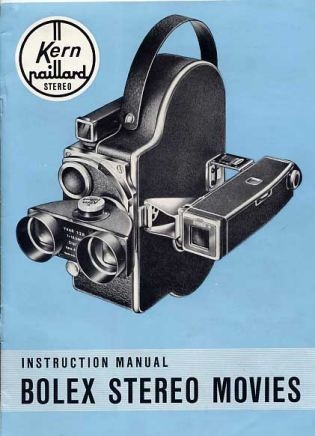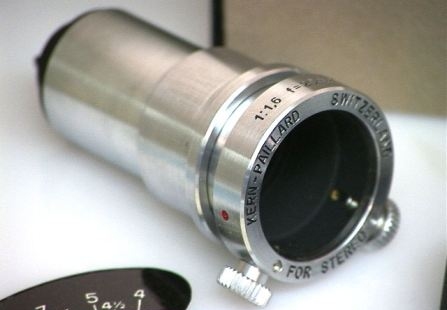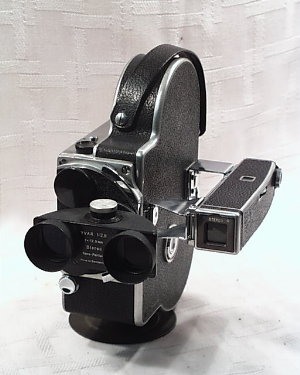Bolex H16 User
For Practical Bolex H16 Filming
Stereo Lens
Bolex Product Code :- STEREO & STOUP
 This
attachment is designed to produce stereoscopic films when used in conjunction
with a Bolex H16 camera. The Stereo employs two Kern lenses mounted 5.3
mm apart, two prisms extend the optical path to a separation of 2.5 inches.
This
attachment is designed to produce stereoscopic films when used in conjunction
with a Bolex H16 camera. The Stereo employs two Kern lenses mounted 5.3
mm apart, two prisms extend the optical path to a separation of 2.5 inches.
The lenses are of the fixed focus type, 0.5 in. (12.5 mm) focal length and with maximum apertures of f2.8. Light passing through these lenses is reflected by prisms so that the two lenses produce separate images, side by side on the normal film frame. The twin images represent the different views of the subject as seen by the left and right eyes of an observer.
Because the two pictures on the film share the space normally occupied by a single picture they are vertical. After exposure through the Stereo, the film is processed as usual but is then projected through a special lens that is supplied with the equipment.
This projection lens is actually two separates complete optical systems arranged so that each system projects one of the pictures on the film. The separate systems contain material that polarises the light passing through them at 90° to each other.
Two types of projection lenses are produced by Paillard. One is designed for the Paillard Bolex Type G projector and the other suits the majority of American and British projectors. The latter lens is fitted with two adjustment knobs, one for vertical alignment of the two images and the other for focusing them.
 The
Type G Stereo projection lens is designed so that it orientates itself
in the lens holder and ensures correct alignment of the images. Focusing
is carried out with the usual projector knob. When the audience put on
the spectacles provided they will immediately see the scene with a definite
three-dimensional appearance. This effect is produced because the spectacle
lenses are also polarised so that each eye sees only the view that was
filmed by the corresponding stereo lens.
The
Type G Stereo projection lens is designed so that it orientates itself
in the lens holder and ensures correct alignment of the images. Focusing
is carried out with the usual projector knob. When the audience put on
the spectacles provided they will immediately see the scene with a definite
three-dimensional appearance. This effect is produced because the spectacle
lenses are also polarised so that each eye sees only the view that was
filmed by the corresponding stereo lens.
The attachment is fitted with a ring that screws into the centre aperture of the Bolex turret. When the Stereo is placed In position it obstructs the field of view of the Octameter viewfinder. To overcome this a metal bracket is provided to extend the viewfinder away from the side of the camera. The vertical-shaped mask is slipped on to the front of the viewfinder and the Stereo is ready for action.
Making Stereo Films
 Three-dimensional
films do not require a special filming technique. To make full use of
the three-dimensional effect, remember that objects in the foreground
will appear to be separated by greater distances than far away objects.
For this reason you should try to compose your subject so that the foreground
contains three or four separate planes of interest. The shadows produced
by side lighting also strengthen the stereoscopic effect. For this reason
some departure from the conventional Flat, frontal lighting for colour
film is possible in stereo work. You can use reverse motion too.
Three-dimensional
films do not require a special filming technique. To make full use of
the three-dimensional effect, remember that objects in the foreground
will appear to be separated by greater distances than far away objects.
For this reason you should try to compose your subject so that the foreground
contains three or four separate planes of interest. The shadows produced
by side lighting also strengthen the stereoscopic effect. For this reason
some departure from the conventional Flat, frontal lighting for colour
film is possible in stereo work. You can use reverse motion too.
The fake car accident will provide a very dramatic result. With your Bolex used upside down and the Stereo on the turret, have a car driver reverse his vehicle at high speed away from the camera.
From a photographic point of view the only unusual thing about the Stereo are the fixed focus lenses. Their very short focal lengths provide great depth of field, at f8 the depth would extend from about 2 ft to infinity.
A special close-up stereo attachment is available which must be fitted by a Bolex workshop. It consists of a circular metal plate containing two sets of prisms. The first set permits stereo filming at distances of 28inches to 7 ft, the second set provides a focusing range from 18 to 34 inches.
![]() The
stereo attachment screws into the centre aperture of the Bolex turret
and produces two Images, side by side, on the film. These images are the
same as those seen by the left and right eyes. A special close-up stereo
attachment is available for near subjects. The special projection lens
projects the two pictures on to the screen through polarising filters.
The naked eye will then perceive them slightly out of register. When the
audience wear polarising glasses supplied with the outfit, they see a
very realistic three-dimensional Image.
The
stereo attachment screws into the centre aperture of the Bolex turret
and produces two Images, side by side, on the film. These images are the
same as those seen by the left and right eyes. A special close-up stereo
attachment is available for near subjects. The special projection lens
projects the two pictures on to the screen through polarising filters.
The naked eye will then perceive them slightly out of register. When the
audience wear polarising glasses supplied with the outfit, they see a
very realistic three-dimensional Image.